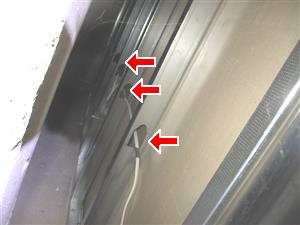Electrical Wiring & Metal Stud Rules
When using Romex cable in metal studs you have to comply to Canadian Electrical Code requirements. One of the common issues it home owners running unprotected Romex cable through steel stud openings. 
Residential buildings are an acceptable place for NM run in steel studs as long as plastic bushings are installed properly , and the building type meets the requirements set forth in the code book for where NM cable can be installed.
Rule 12-516 3) permits the use of NMSC with metal stud construction. Where NMSC is used in metal stud construction, approved inserts (grommets) adequately secured in place is required to protect the cable where it passes through the metal stud in accordance with Rule 12-516 3) b). Round inserts are approved for a given size opening in a steel stud. If inserts are loose fitting or can be easily removed, they are not adequate for that installation and shall be replaced or installed in properly sized holes. Improperly installed inserts can lead to cable insulation failures. Installation of NMSC in steel stud construction will not be accepted where the standards of workmanship or the type of inserts used results in the inserts not staying in place.
Repairing Non-Metallic Cables in Metal Stud Wall
One might think that repairing walls which have Romex cables passing through metal stud walls might be a simple fix as fishing approved cables along the wall, WRONG! Rule 12-520 does not permit cables to be fished where metal joists, metal top or bottom plates, or metal studs are used.
Romex Cables installed in cold air returns
Cables are not permitted to be fished length wise in residential air plenum boxed in sheet metal. Rule 12-520 does not permit cables to be fished where metal sheeting or cladding, metal joists, metal top or bottom plates, or metal studs are used. Cables are allowed to be fished through the sides of a return air plenum. Rule 12-516 3) permits the passing of a cable through the return air plenum if it is protected where it passes through a member by an insert approved for the purpose and adequately secured in place.
Staples and Ties for use with NMSC
Many older homes have two romex cables stapled together when exiting electrical panel and even junction boxes. Newer installations have to comply to Rule 2-034. Cable staples are approved to support one cable only, unless manufacturer documentation is provided to confirm certification for fastening of more than one cable. Supporting more than one cable with a staple that is not approved for fastening more than one cable is a violation of Rule 2-034, which requires equipment to be used only for the specific purpose for which it is approved.
Residential Electrical Installations
Who can do electrical work at my property?
Electrical work is complicated and mistakes can be serious. If you hire someone to do electrical work in your home, by Ontario law, they must be a Licensed Electrical Contractor. Electrical contractors are trained in and understand the safety requirements associated with electrical installations.
General service providers cannot do electrical work in residences unless they hold an electrical contractor’s licence. If you hire a general contractor, confirm that a licensed subcontractor will do the electrical work. A Licensed Electrical Contractor must display their licence number. Ask to see it. You can find a Licensed Electrical Contractor or confirm that your contractor holds a valid licence at https://findacontractor.esasafe.com/
*Exceptions:
- Maintenance, service and repair work on equipment when done by an employer or agent of the equipment manufacturer;
- Work done within an industrial establishment or on a farm by an owner, operator or employee;
- Work on refrigeration and air conditioning units by qualified Refrigeration and Air Conditioning Mechanics;
- Work done on elevators and escalators by a person authorized by the Technical Standards and Safety Authority;
- Work on fire protection systems by qualified sprinkler and fire protection installers;
- Work on natural gas or propane appliances by an approved certificate holder; and
- Maintenance, service or repair on electrical equipment that plugs into an electrical source. This work must not include extending or altering the equipment or installing, extending, altering or repairing any electrical wiring connected to the equipment.
Electrical work can also be done in a home by the homeowner or occupant. (An occupant is someone living in a residence or using the premises, as a tenant or owner; or a person who takes possession of property that has no known owner.) If you choose to do the work yourself, be aware of the responsibilities and risks. Ensure the work is done according to the Ontario Electrical Safety Code and file all required notifications of work to ESA.
The Orillia Home Inspector always checks electrical wiring and panels to ensure they are visibly safe in accordance with CEC requirements. Any suspected deficiencies will be noted with a recommendation to have a Master Electrician inspect and repair any deficiencies. Aluminum wiring is another issue that is checked for during your Home Inspection.
A Professional Home Inspection can prevent unwanted surprises or uplanned expenses. Read List of Items Typically Covered in Home Inspection
